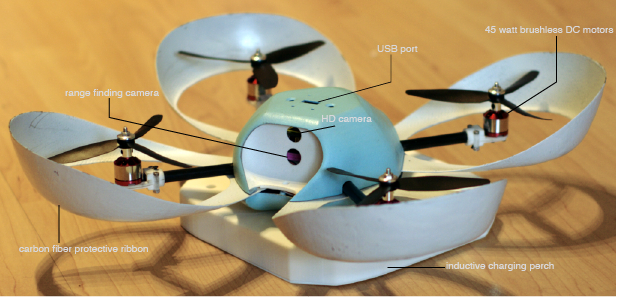
Spiri flying robot
Spiri is a new device project created by Patrick Edwards-Daugherty who designed the “the programmable, autonomous flying robot”.
The Spiri is a physical machine and software platform at the same time. Running on Ubuntu Linux with ROS (Robot Operating System), this concept device has an API and library of flight primitives, which allow developers to add their own functionality on top of the basic features and contribute their apps to the “Spiri hobbyists community”.
In addition to the usual set of sensors like gyroscope, array of accelerometers and magnetometer, Spiri has a lot of other useful sensors. The set is very impressive for the Open Source starter project and contains: GPS, a downward-facing and forward-facing cameras, a downward-facing acoustic sensor, and a forward-facing range finder. Device also has a USB port, which allows to add new sensors or any other periferals. Did we mention a hardware API yet? Yes, Spiri has a hardware API for manufacturers.
The flying robot can fly without a remote control relying on its sensors, which will help Spiri to identify and pass potential obstacles. And if Spiri will get an indication of a low battery during the flight, it will return and land on its inductive charging perch to recharge.
Spiri Technical specifications
| Specifications | Spiri |
|---|---|
| Dimensions | Frame width: 340 mm Frame Length: 340 mm Height: 68 mm Propeller diameter: 135 mm mass: 400 gr |
| Inductive charging perch | Width: 180 mm Length: 180 mm Height: 25 mm Power source: AC adapter |
| Cameras | Downward: 60fps CMOS camera Front range finding: PMD tech TOF camera Front: 720p video camera |
| Sensors | gyroscope, acceleromoter, magnetometer, pressure gauge, accoustic sensor, GPS |
| Processor | 1Ghz Dual Core ARM Cortex A-9 |
| Storage | 4 Gb |
| Connectivity Options | USB, Wifi, Bluetooth |
| Operating System | Ubunty Linux with ROS |
| Battery | 15 mins flying mode, Thrust 650g |



